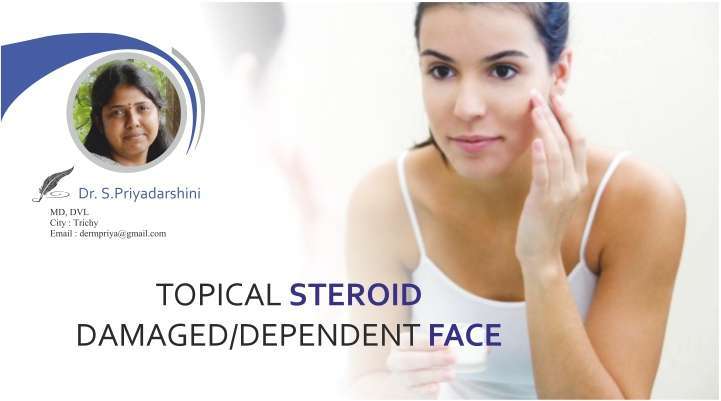Dermatology was once an army with only one weapon – the steroid to tackle so many dermatological diseases. Of course, it has the big advantage of direct drug delivery to the disease site with no systemic side effects. Still TCs are pivotal in every dermatologist’s armory. Anything over-used tends to get more chances of being abused.
The most widely over-used / misused topical agent over face is undoubtedly steroids for a wide range of on and off labeled indications. A number of steroid molecules from least to super potent are misused by the over-the-counter sales and non-dermatologist prescribers. The resultant cutaneous damage in face has varied clinical manifestations.
Facial Skin and Vulnerability:
Certain features that render skin over the face more susceptible to ill-effects of steroids:
- Thinner than other parts
- Drug absorption is more owing to rich blood supply
- More exposed to sunlight: photodamage is collateral
- Succumb more to environmental pollutants
- Concomitant usage of various cosmeticeucals
Clinical Features:
Some describe the changes as “topical steroid damaged/dependent face – TSDF”. Face can have one or many of the clinical presentations among the following: erythema, hyperpigmantation, papules, pustules, nodules, telengiectasia, photosensitive rash, striae, hypopigmentation (rare).
The two specific hallmark features of steroid abuse that make it difficult to convince the patient and need a lot of counseling are:
- Increase in symptoms after withdrawal especially increase in erythema and scaling
- Cyclical pattern of remission and relapse for a period of time (varies with individual patient): they respond to treatment for quite some time interspersed with sudden flares while on treatment followed by clearance and this cycle gets repeated till complete cure.
Management:
Intense moisturisation and adequate sun protection are the mainstay of management. Frequent application of moisturizers should be advised. Sunscreens should be chosen wisely. They should be non comedogenic, hypoallergenic and pH balanced.
Various other treatment options have been tried including topical metronidazole and azoles to counter the altered microbial flora and malassezia over growth owing to steroid induced immunosuppression. Topical hyaluronic acid formulations help skin repair. After adequate skin rejuvenation, various alpha and beta hydroxy acid preparations help in reducing pigmentation that include glycolic acid, kojic acid , mandelic acid and their combinations. Topical glutathione can be of help. Chemical peels and Intense pulse light may be included in treatment but not on acute phase.*-*-*






